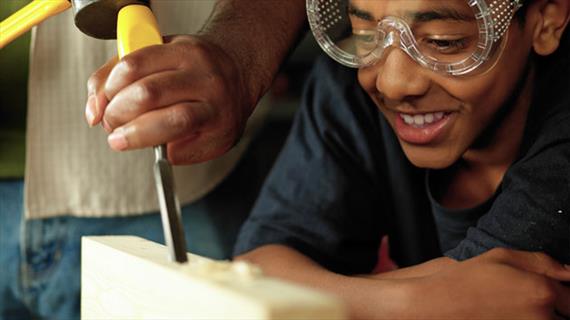Have you heard of the Maker movement? If not, imagine a classroom where students learn though hands-on experimentation, design and trial and error. Where they build rocket ships out of cardboard and dollhouses with working electricity. Where children’s natural instinct to explore their world and to solve problems is encouraged through invention and play.
Behind the Maker Movement
The Maker movement found its inspiration in MAKE Magazine’s annual Maker Faire, billed as the “world’s largest show and tell.” It has since spread through communities, industry and into education. In a pilot program in California, 10 high schools now have “makerspaces” that offer students the opportunity to try machining, welding, woodworking and robotics among other “Maker” skills.
The Maker movement is both low- and high-tech. It celebrates traditional arts and crafts like knitting, manufacturing trades such as steel fabrication, as well as cutting-edge technology like laser cutting and 3D printing. There is an obvious connection to STEM education, but the movement also incorporates the arts, which has led some to call for “STEAM” education in schools.
Just Another Buzzword?
Is the Maker movement just another trend or is it here to stay? It’s possible that the movement is simply a fancy label for what teachers already know—that kids learn best through hands-on, self-directed learning. Chances are, you are already using some “Maker” elements in your classroom, whether you have students build models of volcanoes or tell stories using handmade puppets.
The support for the Maker movement across industries, however, may lead to more support for hands-on learning from administrators and lawmakers. And in the era of the bubble test, that’s good news—especially if that support comes with increased funding for establishing a tricked-out “makerspace” in your own school.
In the meantime, we’ve listed some of our favorite “Maker” resources for education below.
The Maker Movement in Schools: 5 Resources
- The Maker Faire Educational Outreach: Learn how to start a Maker Faire at your own school and connect with other educators interested in the movement.
- Maker Camp: This summer, high school students can try 30 Maker projects in 30 days using online tutorials and community on Google+.
- Makerspace: Discover how you can set up a “makerspace” in your own school.
- DIY.org: A website where young “Makers” can share what they’ve created and connect with other do-it-yourselfers.
- MakeyMakey.com: Billed as “an invention kit for everyone,” the MakeyMakey toolbox allows students to play video games using Play-Doh, make music with bananas and more.
What’s your take on the Maker movement?
